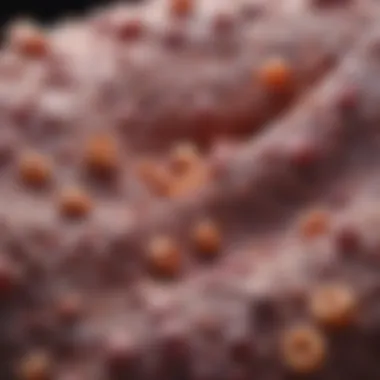Unraveling the Truth: Understanding the Potential Fatality of Basal Cell Carcinoma


Wellness
Basal cell carcinoma, the most prevalent form of skin cancer, sparks curiosity regarding its potential lethality. This article addresses this query by delving into the distinct characteristics of basal cell carcinoma, its associated risks, available treatment modalities, and the prognosis that follows. Understanding the implications of this common skin malignancy is crucial for individuals seeking insights into skin cancer.
- Understanding the Characteristics: Basal cell carcinoma originates in the basal cells of the skin's outermost layer, often manifesting as open sores, red patches, pink growths, or shiny bumps. Exploring these visual cues aids in early detection and efficient management of the condition.
- Evaluating the Risks: While basal cell carcinoma typically exhibits a slow-growing nature and low metastatic potential, neglecting timely intervention can lead to adverse outcomes. Factors such as sun exposure, genetic predisposition, and immune system deficiencies contribute to the susceptibility to this form of cancer.
- Exploring Treatment Options: From surgical excision and Mohs surgery to topical medications and radiation therapy, the array of treatment choices for basal cell carcinoma caters to diverse patient needs. Clinicians tailor the approach based on the tumor size, location, and individual health factors to achieve optimal outcomes.
- Unveiling the Prognosis: Amid advancements in diagnosis and treatment, the prognosis for basal cell carcinoma remains favorable when detected early. Regular skin screenings, adherence to preventive measures, and prompt medical consultation enhance prognosis and mitigate potential complications.
Stay tuned as we unravel the mysteries surrounding basal cell carcinoma, shedding light on its nuances and vital aspects for informed decision-making.
Understanding Basal Cell Carcinoma
Understanding Basal Cell Carcinoma is paramount within the context of this comprehensive article, as it acts as the foundation for delving into the intricacies of this prevalent skin cancer type. By grasping the fundamental aspects of Basal Cell Carcinoma, readers can gain insights into its nature, behaviors, and implications on a deeper level. This section serves as a gateway to exploring the causes, symptoms, treatments, and prognosis associated with Basal Cell Carcinoma.
What is Basal Cell Carcinoma?
Basal Cell Carcinoma is a type of skin cancer that originates in the basal cells, which are located in the lower part of the epidermis. These cells play a crucial role in skin regeneration and are often affected by cumulative sun exposure, triggering abnormal growth and leading to cancerous tumors. Basal Cell Carcinoma usually appears as a pearly or waxy bump on the skin, primarily on sun-exposed areas like the face and neck. While it rarely metastasizes or spreads to other parts of the body, prompt diagnosis and treatment are essential to prevent local tissue damage.
Causes and Risk Factors
The development of Basal Cell Carcinoma is typically linked to prolonged and unprotected exposure to ultraviolet (UV) radiation from sunlight or tanning beds. Individuals with fair skin, a history of sunburns, a weakened immune system, or a genetic predisposition are at a higher risk of developing this type of skin cancer. Moreover, certain environmental factors and occupational hazards, such as exposure to arsenic or coal tar derivatives, can also contribute to the onset of Basal Cell Carcinoma. Understanding these risk factors can aid in adopting preventive measures and promoting skin health.
Symptoms and Diagnosis


Recognizing the signs and symptoms of Basal Cell Carcinoma is crucial for early detection and treatment. Common indicators include open sores that do not heal, red patches, pink growths with rolled edges, shiny bumps, or scars without a known cause. Diagnosis typically involves a thorough examination of the skin lesion, followed by a biopsy to confirm the presence of cancerous cells. Dermatologists utilize various imaging techniques and biopsy methods to assess the extent of the malignancy and determine the most effective treatment approach.
Treatment Options
In the realm of managing basal cell carcinoma, understanding treatment options holds paramount importance. Treatment options encompass a range of strategies aimed at eradicating cancerous growths while preserving skin functionality and aesthetics. Patients grappling with basal cell carcinoma have various avenues to explore, each with its set of benefits and considerations. These options may involve surgical interventions, medication, and topical treatments, or radiation therapy. Deciding on the most suitable treatment approach necessitates meticulous evaluation of individual circumstances, including the tumor size, location, and overall health status. Factors like recovery time, potential side effects, and long-term outcomes also play a pivotal role in treatment decision-making.
Surgical Procedures
Surgical procedures stand out as a cornerstone in the treatment arsenal against basal cell carcinoma. These techniques aim to excise cancerous lesions while minimizing damage to surrounding healthy tissue. Procedures such as Mohs surgery offer high precision through iterative tumor removal, ensuring minimal recurrence rates. Excisional surgery involves cutting out the tumor with a margin of healthy skin to deter cancer spread. Patients undergoing surgical procedures benefit from swift removal of cancerous growths, promoting faster recovery and visible improvements. However, surgical interventions may result in scarring and require careful post-operative care to optimize healing and cosmetic outcomes.
Medication and Topical Treatments
For individuals seeking nonsurgical alternatives or adjunctive therapies, medication and topical treatments offer viable options in managing basal cell carcinoma. Topical treatments like creams or gels containing agents such as imiquimod or fluorouracil target cancer cells directly, promoting controlled cell death. Systemic medications, including hedgehog pathway inhibitors, work internally to inhibit cancer cell growth and progression. While these treatments present a less invasive option for certain patients, they may require consistent application and monitoring for optimal efficacy. Understanding the mechanisms and potential side effects of medication and topical treatments is crucial in making informed decisions about their suitability and feasibility.
Radiation Therapy
Radiation therapy plays a crucial role in the treatment landscape for basal cell carcinoma, offering a non-invasive approach to targeting cancer cells with focused radiation beams. This treatment modality is particularly beneficial for patients with tumors in challenging locations or those unsuitable for surgery. Radiation therapy can effectively arrest cancer growth, shrink tumor size, and alleviate symptoms, enhancing the quality of life for individuals battling basal cell carcinoma. However, potential side effects such as skin irritation, fatigue, and long-term radiation risks necessitate careful deliberation when considering this treatment option. Collaborating with healthcare providers to weigh the benefits and risks of radiation therapy is vital to personalized cancer care and treatment success.
Prognosis and Survival Rate
In the realm of basal cell carcinoma discussion, delving into the Prognosis and Survival Rate serves as a pivotal juncture. Understanding the predicted course of this condition and the chances of survival offers essential insight for individuals grappling with such a diagnosis. Counterbalancing the uncertainty that often accompanies a cancer diagnosis, unveiling the probable outcomes contributes significantly to decision-making processes concerning treatment and lifestyle adjustments. By shedding light on the possible trajectories and expectations, the Prognosis and Survival Rate section aims to equip readers with a sense of preparedness and knowledge, fostering a proactive approach to managing their health.


Factors Affecting Prognosis
To grasp the intricate tapestry of Basal Cell Carcinoma prognosis, one must consider an array of influential factors. From the tumor size and location to the overall health status of the individual, multiple elements intertwine to shape the anticipated prognosis. Additionally, factors such as genetic predisposition, immune function, and response to treatment play a crucial role in dictating the eventual outlook for patients. Accurate assessment of these diverse influencers provides healthcare professionals with a comprehensive framework for tailoring personalized treatment plans and prognostic estimations, heightening the precision and effectiveness of therapeutic interventions.
Survival Rate Statistics
Diving into the realm of Survival Rate Statistics unveils a realm of numerical representations that encapsulate the survival probabilities associated with basal cell carcinoma. Through statistical analysis and longitudinal studies, researchers have garnered insights into the general survival rates for individuals diagnosed with this condition. These statistics not only offer a bird's eye view of the overall prognosis landscape but also provide a nuanced understanding of the variations in survival outcomes based on specific factors. By dissecting these survival rate metrics with meticulous attention, readers can glean a more nuanced comprehension of their prognosis, empowering them to make informed decisions regarding their healthcare journey.
When delving into the intricacies of basal cell carcinoma, the question of its fatality naturally arises. This section aims to demystify the perceived lethality of basal cell carcinoma, shedding light on crucial aspects that shape its prognosis. By understanding the potential risks and outcomes associated with this prevalent type of skin cancer, readers can glean valuable insights into the seriousness of this condition.
Understanding the Lethality of Basal Cell Carcinoma
Within the realm of basal cell carcinoma's lethality lies a nuanced landscape warranting exploration. The emphasis on comprehending the lethal potential of this skin cancer underscores the gravity of timely intervention and informed decision-making. By dissecting vital components such as mortality risk and metastasis potential, a clearer picture emerges, guiding individuals towards optimal management strategies.
Overview of Mortality Risk
The nuanced facet of mortality risk within the context of basal cell carcinoma amplifies the significance of early detection and proactive measures. Exploring the key characteristics of mortality risk unveils its pivotal role in gauging the severity of the condition and charting a course of action. The unique features of mortality risk serve as a basis for prognosis assessment, offering valuable prognostic markers essential for treatment planning and patient care.
Metastasis Potential
Delving into the realm of metastasis potential illuminates the evolving nature of skin cancer progression and its implications on overall prognosis. Unveiling the key characteristics of metastasis potential offers a broader perspective on the disease's aggressiveness and metastatic tendencies. Understanding the unique features of metastasis potential underscores the importance of tailored therapeutic approaches geared towards mitigating the risk of disease spread and optimizing clinical outcomes.


Comparison with Other Types of Skin Cancer
In the landscape of skin cancers, comparing basal cell carcinoma with other variants unveils distinct characteristics and implications for patient care. By juxtaposing the lethality of basal cell carcinoma with other skin cancer types, a comprehensive understanding of their relative risks and prognostic differences emerges. Exploring these comparative aspects deepens insights into the complexities of skin cancer management and underscores the significance of tailored approaches based on tumor behavior and metastatic potential.
Prevention and Self-Care Practices
In the realm of skin health, embracing a proactive approach to prevention and self-care practices stands as a paramount shield against potential disorders. Within the context of basal cell carcinoma, an emphasis on preventative measures shines brightly to ward off the risks associated with this prevalent skin cancer type. By delving deep into the nuances of prevention and self-care practices, individuals can arm themselves with invaluable strategies to safeguard their skin health. Discerning these practices contributes significantly to a holistic understanding of basal cell carcinoma and empowers readers with the knowledge needed to navigate towards a healthier future.
Sun Protection Strategies
When unraveling the layers of sun protection strategies, one must understand the pivotal role they play in shielding the skin from harmful ultraviolet (UV) rays. Effective strategies encompass a multi-faceted approach, including the diligent application of broad-spectrum sunscreen, seeking shade during peak sun hours, and donning sun-protective clothing such as wide-brimmed hats and UV-blocking sunglasses. These strategies, when integrated into daily routines, serve as a bulwark against the damaging effects of UV radiation, thereby reducing the risk of skin cancers like basal cell carcinoma. Inculcating these practices exemplifies a proactive stance towards preserving skin health and averting potential harms.
Regular Skin Checks
Regular skin checks epitomize a crucial component of maintaining dermatological vigilance, especially concerning the early detection of skin irregularities like basal cell carcinoma. By routinely examining the skin for any suspicious growths, changes in moles, or peculiar skin lesions, individuals heighten their chances of spotting abnormalities that warrant further evaluation by a healthcare professional. Vigilance in performing skin checks brings to light potential concerns at their nascent stages, facilitating prompt intervention and timely management. This practice underscores the significance of proactive self-monitoring in skin health maintenance and underscores the adage that prevention is undeniably better than cure.
Conclusion
In the realm of skin cancer discussions, the Conclusion section stands as a pivotal juncture, offering a nuanced reflection on the intricate web of information dissected throughout this article. For readers seeking a comprehensive understanding of the lethality of basal cell carcinoma, this segment serves as a beacon of clarity and wisdom. The importance of the Conclusion lies not only in summarizing key points but also in paving the way for informed decision-making and heightened awareness.
With a sagacious focus on specific elements illuminated during the exploration of basal cell carcinoma, the Conclusion encapsulates the criticality of proactive measures in combating this prevalent skin cancer type. By distilling complex details into digestible insights, the Conclusion empowers individuals to navigate the labyrinth of skin health with renewed confidence and acumen. It serves as a bridge connecting theoretical knowledge to practical application, fostering a culture of vigilance and self-advocacy.
Moreover, the benefits inherent in delving deep into the topic of basal cell carcinoma's lethality are manifold. From unraveling the subtle nuances of mortality risk to shedding light on metastasis potential, the Conclusion acts as a compass guiding readers through the maze of uncertainties surrounding skin cancer prognosis. By equipping individuals with comprehensive knowledge, this section empowers them to make informed choices regarding prevention, diagnosis, and treatment options.
Furthermore, considerations about the Conclusion extend to the broader landscape of healthcare awareness and advocacy. By underlining the significance of regular skin checks and sun protection strategies, the Conclusion underscores the transformative impact of early detection and preventive measures in mitigating the risks associated with basal cell carcinoma. It instills a sense of responsibility and ownership in readers, compelling them to prioritize their skin health with diligence and foresight.
In essence, the Conclusion traverses beyond a mere endpoint, transcending into a realm of enlightenment and empowerment. It is a testament to the human capacity for resilience and adaptability in the face of health challenges, urging individuals to embrace knowledge as a shield against the unknown. Through introspection and education, the Conclusion symbolizes a step towards holistic well-being and informed decision-making in the realm of skin cancer management.



